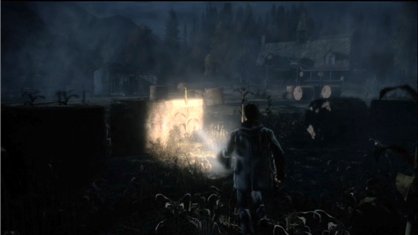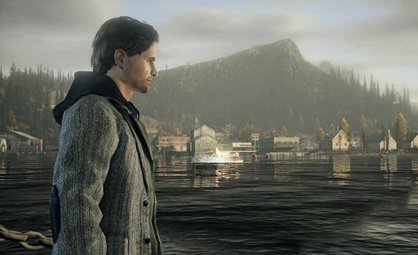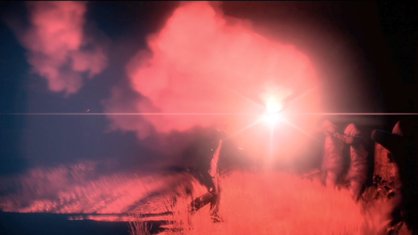The mystery of Alan Wake revealed
In eight strung out episodic parts...
Alan Wake has been in development for over six years. To give you an idea of how long ago this is, in 2004 GTA: San Andreas had only just come out. The 360 and PS3 were still apples in their respective R&D departments' eyes. The PSP was only in its infancy. MySpace was bigger than Facebook. Twitter didn't exist. Lady Gaga was a nobody.
Se 1 Ep 1: Why has it taken so bloody long?
So when you ask Remedy what they've been doing all this time, they've got a lot of stock excuses stored up to justify the thousands of man and woman hours expended on the project; they are a small team (less than 50 people for most of the project), they built all the game technology themselves from scratch and, most pertinently: they've needed the time to 'polish' the game to near perfection (polish that only the Remedy themselves will ever truly appreciate, surely).

Above: In case you hadn't clicked yet, Alan spends a lot of time with a torch
All valid points, but we have suspicions that there are other underlying factors at play which have been tactically scrubbed from the development diary as part of the publicity merry-go-round. Like the fact that Alan Wake morphed from a 'open-world' game to a linear story-based enterprise, suggesting a significant change in gameplay during the creative process. It's also conceivable that other Remedy commitments may have interfered (ie. Max Payne). And at some point Microsoft decided it wanted Remedy to make this an episodic game with DLC - surely this would have added some more months to the schedule.
Fact is, when a game takes this long to break cover, it becomes a talking point - and also raises the level of expectation and anticipation when the thing finally comes out.
BTW: We would have accepted a straight, "Because that's how long it takes to make a game like this with a small team, you nosey bastard" as an honest answer...
Se 1 Ep 2: Why is he called Alan?
This is one part of the mystery we will NEVER KNOW.
Weekly digests, tales from the communities you love, and more

Above: He is called Alan
Se 1 Ep 3: What's with the torch?
While Master Chief has a Plasma Rifle, Sergeant Ramirez an RPD and Chris Redfield a Broken Butterfly, Alan Wake, a troubled writer on vacation, sports a battery-powered torch as his instrument of death. The simple explanation for this is that his enemies in the game, the 'taken' - possessed humans, animals and other heavy objects, like combine harvesters - are strongly inconvenienced by light. A bit like vampires.

Above: Come on Alan, get that torch shone
Playing the opening chapter doesn't reveal why, but in this training level posing as a nightmare sequence, you will marvel at the devastating effect of shining a flashlight into one of the 'taken's' eyes - they disintegrate, lose their dark powers and allow you to finish them off with a regular hand-gun. Yes, you're still allowed a firearm to 'make sure'. Remedy has come up with a handy catchphrase in case you're still unclear what the torch is for: "fight, with light". Simple.
Se 1 Ep 4: What sort of game is this?
Our first mental comparison was to a more cerebral, subtle, Resident Evil. Whether you think the plot is a bit hokey or not, you have to admire Remedy for having ambition with their storytelling. The lead character is a regular author, not a super-hero and his motivation is at first truly human - his wife goes missing on the first day of their vacation in an isolated lakeside town called Bright Falls. The story then concerns his efforts to find out where she’s gone and whether he’s losing his mind or he really is living out the story of a book a can't remember writing.
But, it is mostly about walking around at night torching and shooting zombie-like characters in forests. You can’t hide from that.
Alan’s life is split between two themed game styles. There’s the daytime, which he spends gathering information, talking to the Bright Falls residents and moping about in diners, and the night time when he heads off into the woods, switches on his torch and points it at stuff.

Above: Alan is assistedby friends druring some combat sequences
From the players point of view this gives balance; the small-town location is as eerie as can be managed in a videogame and helps to build atmosphere and develop the plot, while the action and combat focused night segments are when you get a chance to cut loose with all manner of light sources and guns. While your torch is your primary weapon, more powerful flashbangs, floodlights and flare guns become available later, as the ‘taken’ become ever more threatening and plentiful.

Above: Go on, have some flare. You don't like that do you?
Resource management quickly becomes important - your torch needs batteries and your gun ammunition - use them with reckless abandon and you’ll soon find yourself up shit creek. Upgrades are provided as you progress in the guise of longer-life lithium batteries and more powerful shotguns. These are scattered throughout the buildings you encounter.
More over the page including video footage...



